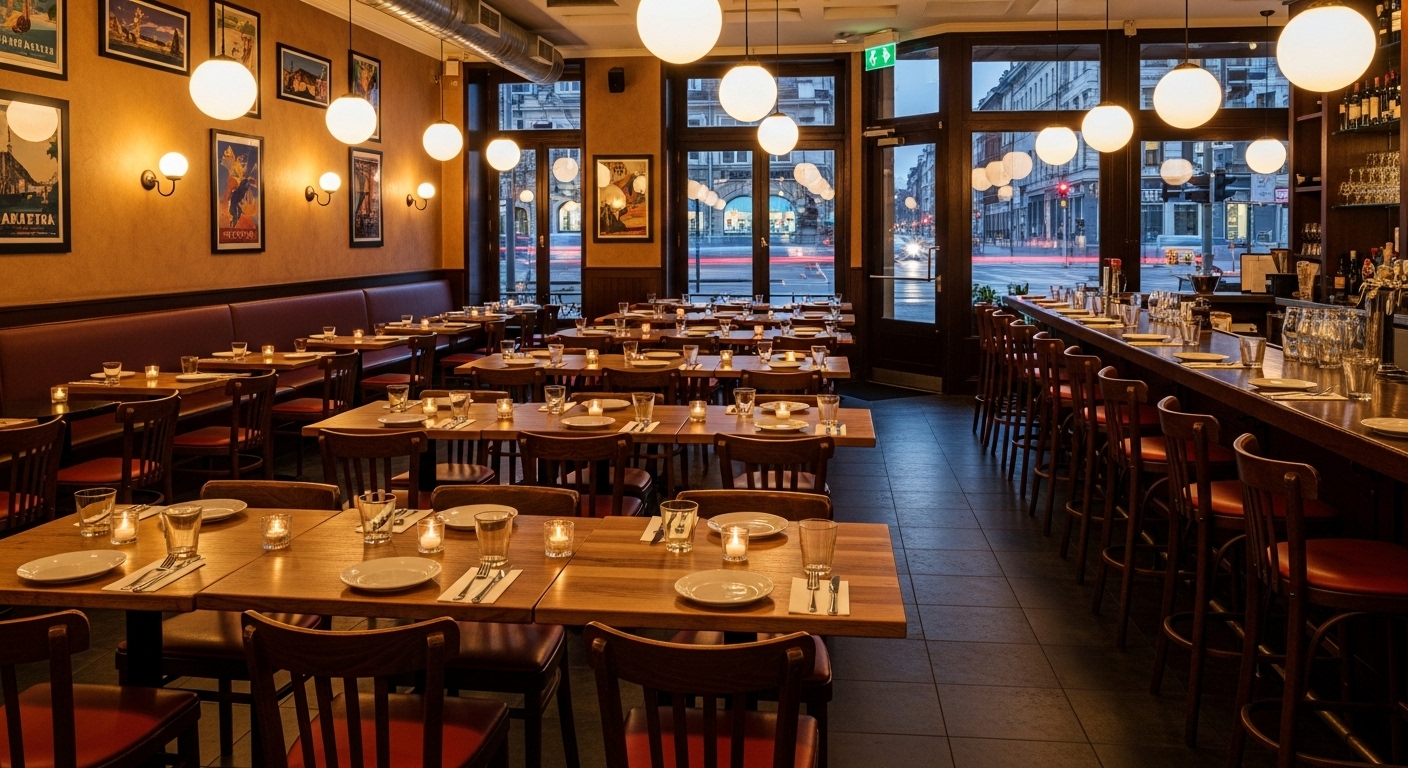The True Cost of Restaurant No-Shows and 5 Proven Ways to Reduce Them


No-shows are one of the most frustrating and costly challenges facing UK restaurants, bars, and cafes today. With an estimated £13 billion lost annually to no-shows and late cancellations across the hospitality industry, finding effective solutions has never been more critical for protecting your bottom line and maintaining operational efficiency.
Understanding the True Cost of No-Shows
When a customer fails to honour their restaurant reservation, the impact extends far beyond an empty table. The true cost of no-shows includes:
Direct Revenue Loss
Every no-show represents immediate lost revenue. A table for four at an average spend of £120 means £120 in lost sales that evening. For restaurants operating on tight margins (typically 3-5% in the UK), this loss can be devastating. Multiply this across multiple no-shows per week, and you're looking at thousands of pounds in annual revenue loss.
Opportunity Cost
Perhaps even more damaging is the opportunity cost. That empty table could have been filled by another customer who was turned away because you were "fully booked." During peak times—Friday and Saturday evenings, special occasions, or holiday periods—this opportunity cost multiplies significantly.
Staff and Resource Waste
Your restaurant prepared for those guests. Staff were scheduled, ingredients were purchased and prepped, and tables were set. All of these resources were allocated based on expected covers, and no-shows mean wasted labour costs, food waste, and inefficient resource allocation.
Impact on Team Morale
Repeated no-shows affect staff morale and earnings. Servers lose potential tips, kitchen staff prepare for covers that never arrive, and the entire team experiences the frustration of wasted effort. This can lead to decreased job satisfaction and higher staff turnover.
Damage to Reputation
When you turn away walk-in customers because you're "fully booked," only to have multiple no-shows, you're damaging your reputation. Those turned-away customers may never return, and they'll likely share their negative experience with others.
Why Do Customers No-Show?
Understanding the psychology behind no-shows is crucial for developing effective prevention strategies:
Multiple Bookings
Many customers make reservations at several restaurants for the same evening, planning to cancel the others. However, they often forget to cancel, leaving you with an empty table.
Changed Plans
Life happens. Plans change, emergencies arise, or customers simply change their minds. While understandable, the lack of communication creates problems for restaurants.
Low Perceived Consequences
When there's no deposit required and no perceived consequence for not showing up, some customers simply don't prioritize honouring their reservation. The booking feels "free" and therefore disposable.
Forgetfulness
In our busy lives, customers genuinely forget about reservations, especially those made weeks in advance without reminder systems in place.
Serial No-Show Behaviour
A small percentage of customers are repeat offenders—serial no-shows who consistently fail to honour reservations across multiple establishments. Without a system to identify these customers, restaurants continue to accept their bookings.
5 Proven Strategies to Reduce Restaurant No-Shows
Implement Customer Karma Scoring
Customer intelligence is revolutionizing how restaurants manage bookings. A karma scoring system tracks customer behaviour across reservations, creating a comprehensive profile that helps you make informed decisions.
How it works:
Customers start with a neutral karma score (typically 50 out of 100)
Positive behaviours (honouring reservations, arriving on time, being courteous) increase their score
Negative behaviours (no-shows, late cancellations, double-booking) decrease their score
Scores inform your booking policies and help identify high-risk reservations
Benefits:
Identify serial no-shows before accepting their bookings
Prioritize reliable customers during peak times
Make data-driven decisions about deposit requirements
Reduce no-shows by up to 40% by focusing on customer behaviour patterns
Implementation tip: Use a customer reputation management platform like KarmaLink that automatically tracks and scores customer behaviour while maintaining GDPR compliance through email hashing and privacy-first design.
2. Send Strategic Automated Reminders
Reminder systems are one of the simplest yet most effective tools for reducing no-shows. However, timing and frequency matter.
Best practices:
Send a confirmation immediately after booking
Send a reminder 24-48 hours before the reservation
Send a final reminder 2-4 hours before the reservation
Include easy cancellation options in every reminder
Use multiple channels: email, SMS, and app notifications
What to include:
Reservation date, time, and party size
Your cancellation policy
Easy one-click cancellation link
Contact information for changes
Special notes about deposits or prepayment
Results: Restaurants implementing strategic reminder systems report 15-25% reductions in no-shows, with the highest impact coming from the 24-hour reminder.
3. Require Deposits for Peak Times and Large Parties
Requiring a financial commitment significantly reduces no-show rates by creating a tangible consequence for not honouring the reservation.
When to require deposits:
Weekend evenings (Friday and Saturday)
Special occasions (Valentine's Day, Mother's Day, New Year's Eve)
Large parties (typically 6+ guests)
High-demand time slots
Customers with low karma scores
Deposit strategies:
£10-20 per person for standard reservations
50% of estimated bill for large parties
Full prepayment for tasting menus or special events
Refundable with 24-48 hours notice
Non-refundable for same-day cancellations
Implementation tip: Use your karma scoring system to determine which customers require deposits. High-karma customers with proven reliability may not need deposits, while new or low-karma customers should always provide one.
4. Build a Customer Intelligence Database
Knowledge is power when it comes to managing reservations. A comprehensive customer intelligence database helps you track patterns, identify risks, and make informed decisions.
What to track:
Reservation history (honoured, cancelled, no-showed)
Cancellation timing (advance notice vs. last-minute)
Spending patterns and average check size
Special requests and dietary requirements
Punctuality (on-time vs. late arrivals)
Behaviour and courtesy ratings
Double-booking patterns
How to use this data
Flag high-risk bookings for follow-up calls
Offer priority reservations to reliable customers
Adjust deposit requirements based on customer history
Identify and block serial no-shows
Personalize service for VIP customers
Privacy considerations: Ensure your system is GDPR compliant by using email hashing (SHA-256), obtaining proper consent, and providing customers with data access and deletion rights.
5. Communicate Clear Cancellation Policies
Transparency about your cancellation policy sets expectations and reduces no-shows by making consequences clear.
Effective policy elements:
Clearly stated cancellation deadline (e.g., 24 hours notice)
Specific consequences for no-shows (deposit forfeiture, booking restrictions)
Easy cancellation process (one-click links, phone number)
Grace period for emergencies
Escalating consequences for repeat offenders
Where to communicate:
Booking confirmation email
Website booking page
Reminder messages
Table reservation cards
Social media profiles
Example policy: "We require 24 hours notice for cancellations. Cancellations with less than 24 hours notice or no-shows will result in forfeiture of your deposit. Repeat no-shows may result in restrictions on future bookings. We understand emergencies happen—please call us to discuss special circumstances."
Measuring Success: Key Metrics to Track
To understand the effectiveness of your no-show reduction strategies, track these key performance indicators:
No-Show Rate
Calculate your no-show rate: (Number of no-shows ÷ Total reservations) × 100
Industry benchmarks:
Average UK restaurant: 15-20%
Well-managed restaurant: 5-10%
Excellent systems: Under 5%
Revenue Recovery
Track the revenue recovered through reduced no-shows:
Monthly revenue from previously no-showed tables
Opportunity cost recovered from better table management
Increased covers from improved booking accuracy
Customer Behaviour Trends
Monitor changes in customer behaviour:
Percentage of customers with improving karma scores
Reduction in repeat no-shows
Increase in advance cancellations (vs. no-shows)
Improvement in on-time arrivals
Operational Efficiency
Measure improvements in operations:
More accurate staff scheduling
Reduced food waste
Better table turnover
Improved team morale
Common Mistakes to Avoid
Being Too Lenient
While you want to be understanding, being too lenient with no-shows encourages repeat behaviour. Enforce your policies consistently.
Complicated Cancellation Process
If it's difficult to cancel, customers won't bother—they'll just not show up. Make cancellation easy with one-click links and clear contact information.
Ignoring Data
Collecting customer behaviour data is pointless if you don't use it. Review your data regularly and adjust policies based on what you learn.
Treating All Customers the Same
Your most reliable customers shouldn't face the same restrictions as serial no-shows. Use karma scoring to differentiate and reward loyalty.
Poor Communication
Unclear policies, missing reminders, or confusing messages contribute to no-shows. Ensure all communication is clear, timely, and professional.
Taking Action: Your Next Steps
Reducing no-shows requires a systematic approach combining technology, clear policies, and customer intelligence. Here's how to get started:
Week 1: Assess Your Current Situation
Calculate your current no-show rate
Estimate your annual revenue loss
Review your existing policies and systems
Identify your biggest pain points
Week 2: Implement Quick Wins
Set up automated reminder systems
Create clear cancellation policies
Start tracking customer behaviour manually
Require deposits for peak times
Week 3: Invest in Technology
Research customer reputation management platforms
Implement a karma scoring system
Integrate with your existing booking system
Train staff on new procedures
Week 4: Monitor and Adjust
Track your no-show rate weekly
Review customer feedback
Adjust policies based on results
Celebrate improvements with your team
Conclusion
No-shows don't have to be an accepted cost of doing business. By implementing customer intelligence systems, requiring strategic deposits, sending automated reminders, building a comprehensive customer database, and communicating clear policies, UK restaurants have successfully reduced no-shows by 40% or more.
The key is taking a data-driven approach that treats different customers differently based on their behaviour. Your most reliable customers deserve priority treatment, while serial no-shows should face appropriate consequences.
Start with one or two strategies today, measure your results, and gradually build a comprehensive no-show prevention system. Your revenue, your team, and your reliable customers will thank you.
Ready to reduce your no-shows? Learn more about how KarmaLink's customer reputation management platform can help you implement these strategies with minimal effort and maximum results. Our karma scoring system, automated tracking, and GDPR-compliant customer intelligence database make it easy to identify risks, reward loyalty, and protect your revenue.